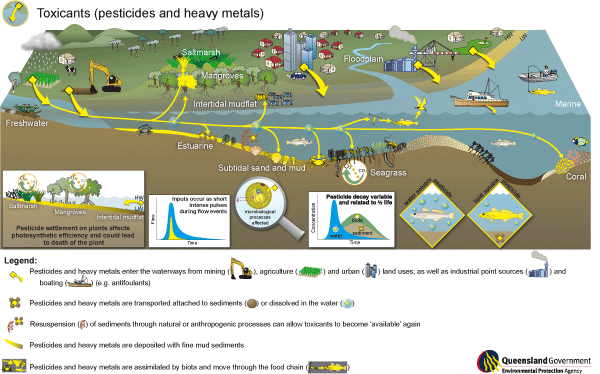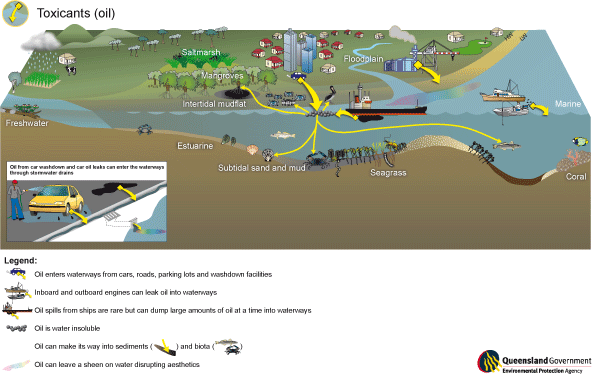Our current best conceptual understanding of the stressor ‘metal and pesticide toxicants’ is shown in Figure 1.
Figure 1. Potential causes of a change to ‘metal and pesticide’ toxicants and the condition responses observed as a result of this change.
Our current best conceptual understanding of the stressor ‘oil toxicants’ is shown in Figure 2.
Figure 2. Potential causes of a change to ‘oil’ toxicants and the condition responses observed as a result of this change.
Toxicants are chemicals or a mixture of chemicals that present a risk of death, disease, injury or birth defects in exposed organism at certain doses. They can be natural (e.g. metals such as zinc and copper) which are essential for life but become toxic at high concentrations) or unnatural (i.e. man-made substances such as pesticides). Common toxicants in waterways include oil, herbicides, pesticides, heavy metals, industrial compounds and plastics. These toxicants range widely in their sources and effects.
Heavy metals, metalloids and organometallics are used in many common items and may enter coastal waterways through point-source discharges (e.g. industrial or sewage discharges) or through diffuse run-off. Most point-source discharges are controlled by a discharge licence. Concentrations in diffuse run-off are usually higher in run-off originating from urban areas; for example, copper is used in car brake linings and is therefore higher in areas with high road density; zinc concentrations in run-off may be related to roof density. High concentrations of heavy metals in coastal waters can lead to health problems in aquatic biota, including diseases and fish kills. Human health problems can also result from consumption of contaminated seafood.
Pesticides (which includes herbicides, insecticides, etc.) are used in both rural and urban areas to control pest plants, insects and other animals. The term pesticides can be used as a general term to encompass any chemical product used to kill a pest, whether the pest is animal or plant. In rural areas, pesticides are generally used to control weeds and insect pests on crops. In urban areas, uses can include termite and pest control in residences, weed control in private and public areas and mosquito control. Pesticides are of concern as they commonly have some effect on non-target organisms, particularly in aquatic systems. Pesticides can enter waterways via a number of pathways, including leaching through the groundwater, surface run-off, soil erosion, aerial drift or spills. Pesticides vary in the time they take to break down (their half-life), the toxicity of breakdown products, their tendency to adsorb to sediment or be taken up by organisms and their toxicity to non-target organisms, and may present problems even after their use has been discontinued. Pesticide residues have been found to be present in many aquatic systems in Australia.
Oil is most commonly sourced from urban run-off or boats. Oil does not have a high toxicity but can cause taste problems in seafood in locations subject to consistent discharges, but this is now a rare occurrence. The incidence of unsightly slicks and the effects on aesthetic values are seen as the main issue with this stressor. Large oil spills from tankers or the like are specific cases and are also considered here.
Toxicants can have a local or more widespread impact depending on the chemical involved. Some readily bind to sediments whereas other are highly water soluble and can be dispersed over large areas. The impact may also vary over time with some breaking down rapidly over a matter of days whereas others, such as DDT, may last may years or decades. Toxicant additivity, antagonism and synergism are also important factors to consider when determining the possible impacts of particular toxicants on the organisms of a waterway. However, currently there is almost nothing known about these aspects of toxicant interactions.




